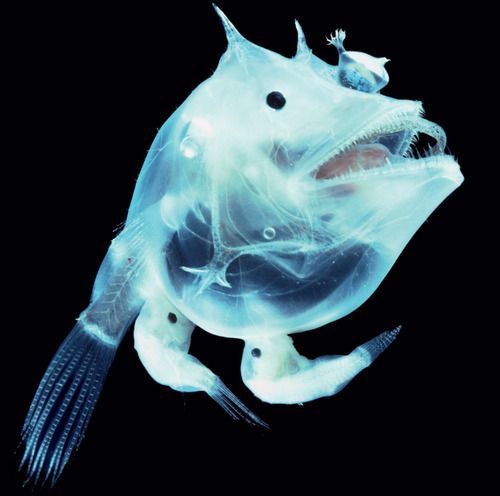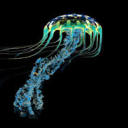Squarenose Helmetfish

Squarenose Helmetfish
Scopelogadus beanii
The Squarenose Helmetfish is found between 800m to 4000m in the ocean. It received this unique name due to its scales reminding scientists of an armored helmet worn by medieval knights. It also has unusual holes around its face, and the white strands covering its face are sensory canals.
Photo credit: https://www.vistaalmar.es/especies-marinas/peces-extranos/449-que-peces-mas-extranos.html
More Posts from Bioluminescentoceangoddess and Others


Jewel Squid
Histioteuthis heteropsis
The Jewel Squid is covered in color-changing photophores that resemble sparkling gem stones. They also have a light-red coloration and are about 20 cm in length. They display a unique behavioral adaptation called diel migration. During the day, they stay at depths around 400-1200 m, and then surface during night (0-400m). This behavioral pattern is designed maximize feeding at night, and avoid predators during the day. The primary predator of the Jewel Squid is the Sperm Whale.
Photo credit: https://www.pinterest.com/pin/722827808920240115/
https://twitter.com/theoctonation/status/1168516522270253056

Pram Bug
Phronima sedentaria
The Pram Bug is a deep sea amphipod that is located between 200 to 1000m in the ocean. It has a translucent exoskeleton and can see primarily blue light. It is also is contained in a hollowed out barrel that is used for protection and to house babies. The image above is a female pram bug carrying its young.
Photo Credit:https://ocean.si.edu/ocean-life/invertebrates/phronima-female-and-young

Periphyllopsis braueri
The Periphyllopsis braueri is a tiny, deep sea jellyfish that is only 6 cm in diameter. It is red-chocolate in color, and it has eight gonads. Furthermore, it is found at depths between 600m to 1000m.
Photo credit: https://oceanexplorer.noaa.gov/explorations/19gulfofalaska/logs/aug2/aug2.html



Fangtooth
Anoplogaster cornuta
The Fangtooth is a ferocious predator that is found at depths between 600 m to 5000 m. It has large, needle like teeth that are used to catch prey. It also has extremely sensitive sensory canals underneath of its scales used to detect movement in the water. Furthermore, their preferred prey are crustaceans and fish.
Photo credit: https://pixels.com/featured/fangtooth-fish-dant-fenolio.html
https://www.pinterest.com/pin/845902742487789950/
https://www.newscientist.com/article/mg23231020-400-up-close-with-the-giant-teeth-of-the-deepsea-fangtooth/


Deep-sea white anglerfish
Haplophryne mollis
The Deep-sea white anglerfish is a ghostly white creature found at depths between 1000m to 4000m. The strange bulge between its eyes is a bioluminescent lure. The main fish above is a female and the tiny fish attached to her body are males. Since it is difficult to find mates in the deep ocean, male fish latch onto the female with hooked teeth. Even though the male fish are parasitic, they are eventually reduced to pockets of sperm that are used for reproduction. For all you fellas out there that have a rough time with the ladies, be thankful that you are at least not a bag of gonads floating through the ocean.
Photo credit: https://www.pinterest.co.uk/pin/440297301041956897/
https://news.cgtn.com/news/3d3d414d3559444f7a457a6333566d54/share_p.html


Cockatoo Squid
Galiteuthis phyllura
The Cockatoo squid is a highly-specialized oddity of the deep ocean and found at depths between 300 to 1400 m. It is completely transparent, except for its eyes. It also has bioluminescent photophores that are directed downward: this makes it difficult for deep sea predators to see the Cockatoo Squid. It was named after the Cockatoo because it holds its tentacles above its head, resembling the bird. The Cockatoo squid can also get fairly large with adults reaching lengths of 2.7 meters (over 6 ft.)
Photocredit: https://www.americanscientist.org/article/at-home-in-the-dark
https://www.pinterest.com/pin/28710516347382519/

Threadfin Snailfish
Careproctus longifilis
The Threadfin Snailfish resembles a prehistoric tadpole that is ghostly white. The holes in its face are large sensory pores that help them detect changes in the ocean. It is often found at depths between 1900 to 2997 meters.
Photo credit: https://www.timeout.com/singapore/museums/creatures-of-the-deep


Googly-eyed glass squid
Teuthowenia pellucida
The Googly eyed squid is a rare oddity that is found in the southern hemisphere. It has a large, spherical head that is filled with water and teeny, tiny tentacles that help propel it through the water. If it comes across a predator, it deflates its head and draws its tentacles into its cavity. On the other hand, it may also fill the cavity with water to increase its size, and intimidate the predator. If all fails, it will ink and try to escape through the darkness. Furthermore, baby squids can be found at the surface (0-600m); then slowly migrate downwards as they mature into adults (1600-2500m).
Photo credit: http://animaladay.blogspot.com/2011/07/googly-eyed-glass-squid.html
https://faunafabula.tumblr.com/post/5999675353/googly-eyed-glass-squid-teuthowenia-pellucida


Blacksnout Seasnail
Paralipparis copei copei
The Blacksnout Seasnail may not look like a snail, but it does have a slimy, gelatinous substance that covers its body. It can be found at depths between 200 m to 1692 m, and adults grow up to be 17 cm in size (approximately 6.5 in). It also has an elongated body that resembles an eel. Furthermore, it can be seen rolling itself in a loop; this behavior is a defensive posture that makes it appear like a jelly. In the darkness, predators tend to avoid the Blacksnout Seasnail because its often mistaken as a hunter due to its appearance and behavior.


Pink Helmet
Aglantha digitale
The Pink Helmet is a mini hydromedusa that comes in a variety of vibrant colors. The tiny jelly is only 4 cm in size and is found towards the surface of the ocean. The purple and blue hues we see in its bell are caused by a phenomenon known as iridescence, when light strikes the jelly’s thin tissue at different angles (similar to what we see in a soap bubbles). It also has orange pigmentation near its mouth; this pigmentation helps attract prey and mask luminescence. Furthermore, females tend to be more colorful than males.
Photo credit: https://biolum.eemb.ucsb.edu/organism/pictures/aglantha.html
https://www.pinterest.com/pin/186899453255850798/
-
 corruptedstructure reblogged this · 1 year ago
corruptedstructure reblogged this · 1 year ago -
 drumgistlure liked this · 1 year ago
drumgistlure liked this · 1 year ago -
 stardustandmoonflowers liked this · 1 year ago
stardustandmoonflowers liked this · 1 year ago -
 hobby-zoologist reblogged this · 2 years ago
hobby-zoologist reblogged this · 2 years ago -
 deep-sea-scholar liked this · 2 years ago
deep-sea-scholar liked this · 2 years ago -
 saltmatchescandlewax reblogged this · 2 years ago
saltmatchescandlewax reblogged this · 2 years ago -
 rickyratking liked this · 2 years ago
rickyratking liked this · 2 years ago -
 dungeonbastards liked this · 2 years ago
dungeonbastards liked this · 2 years ago -
 skykaykay liked this · 2 years ago
skykaykay liked this · 2 years ago -
 experimentv reblogged this · 2 years ago
experimentv reblogged this · 2 years ago -
 experimentv liked this · 2 years ago
experimentv liked this · 2 years ago -
 chadderino liked this · 2 years ago
chadderino liked this · 2 years ago -
 judathian reblogged this · 2 years ago
judathian reblogged this · 2 years ago -
 judathian liked this · 2 years ago
judathian liked this · 2 years ago -
 miraphoenix liked this · 2 years ago
miraphoenix liked this · 2 years ago -
 thatonetreetho reblogged this · 2 years ago
thatonetreetho reblogged this · 2 years ago -
 thatonetreetho liked this · 2 years ago
thatonetreetho liked this · 2 years ago -
 queerplantbaby liked this · 2 years ago
queerplantbaby liked this · 2 years ago -
 mushroomancy reblogged this · 2 years ago
mushroomancy reblogged this · 2 years ago -
 dweomerthread liked this · 2 years ago
dweomerthread liked this · 2 years ago -
 fatehbaz liked this · 2 years ago
fatehbaz liked this · 2 years ago -
 fatehbaz reblogged this · 2 years ago
fatehbaz reblogged this · 2 years ago -
 hemulpajun reblogged this · 2 years ago
hemulpajun reblogged this · 2 years ago -
 hemulpajun liked this · 2 years ago
hemulpajun liked this · 2 years ago -
 dimens1ons liked this · 3 years ago
dimens1ons liked this · 3 years ago -
 hmmmmho liked this · 3 years ago
hmmmmho liked this · 3 years ago -
 low-level--00 reblogged this · 3 years ago
low-level--00 reblogged this · 3 years ago -
 low-level--00 liked this · 3 years ago
low-level--00 liked this · 3 years ago -
 wormslurry liked this · 3 years ago
wormslurry liked this · 3 years ago -
 redwolf1999 liked this · 3 years ago
redwolf1999 liked this · 3 years ago -
 amaurylandia liked this · 3 years ago
amaurylandia liked this · 3 years ago -
 girlfromvagina liked this · 3 years ago
girlfromvagina liked this · 3 years ago -
 sothatidostuff reblogged this · 3 years ago
sothatidostuff reblogged this · 3 years ago -
 algaejay liked this · 3 years ago
algaejay liked this · 3 years ago -
 fish-fido liked this · 3 years ago
fish-fido liked this · 3 years ago -
 maricruz-camacho liked this · 3 years ago
maricruz-camacho liked this · 3 years ago -
 veronicahhh liked this · 3 years ago
veronicahhh liked this · 3 years ago -
 pizzaalien48 liked this · 3 years ago
pizzaalien48 liked this · 3 years ago -
 ramblingismypassion liked this · 3 years ago
ramblingismypassion liked this · 3 years ago -
 sirneb liked this · 3 years ago
sirneb liked this · 3 years ago

Bioluminescence is a chemical reaction that produces light. Many deep sea animals use bioluminescence. This blog is dedicated to educating the public about the amazing creatures that thrive in the deep sea.
57 posts